
As Boston celebrates its big
375th anniversary, Panorama looks at seven big and small ways the
city has changed
by Josh B. Wardrop and Diana Aramburu
 I'll see your Custom House, and
raise you a John Hancock
I'll see your Custom House, and
raise you a John Hancock
When the 30-story tower of the Boston
Custom House was built in 1915, giving the city its first
skyscraper, Bostonians would have scoffed at the prospect of
anything taller. And for almost 50 years, they'd be right. Then
the 750-foot high Prudential Tower came on the scene in 1964 and
took over the top spot on the Boston skyline. Today, though,
they're both trumped by the I.M. Pei-designed John Hancock Tower,
built in 1976, which stands 62 stories high. Sure, at 788 measly
feet tall it's only 71st in the world, but here in Boston, it's
#1.
 Women no longer
"Locked" out of legendary restaurant
Women no longer
"Locked" out of legendary restaurant
It's served up gourmet cuisine and favored New
England fare to Boston bluebloods and foreign dignitaries for 130
years, but there was at least one dining demographic all but
ignored by Boston's ritzy Locke-Ober restaurant until 1971-women.
As recently as 35 years ago, the downstairs dining area at Locke-Ober
was off-limits to the fairer sex.
Today, Locke-Ober's come a long way, baby. Not only are women welcome to break sweetbreads with their male counterparts, but they've got one of their own calling the shots at the venerable eatery. Legendary chef, culinary innovator and restauranteur Lydia Shire (Biba, Excelsior) became co-owner of Locke-Ober in 2001, and today she determines what gets served in a dining room where, decades ago, she would not have been allowed to set foot.
 A whole new Ballgame
A whole new Ballgame
Last year something nearly unthinkable happened: after an epic
86-year drought, the Boston Red Sox won the World Series. As
life-changing as that was for Sox fans, most would argue the best
part was that the Olde Towne Team staged the greatest comeback in
baseball history against the hated New York Yankees along the
way. It was the beginning of a shift in what was considered the
traditional balance of power, making for perhaps the biggest
change that's happened to Boston in 375 years. (Well, right after
the American Revolution, the rise of modern industry and all that
jazz, anyway.)

With Red Sox tickets now harder to come by than ever, many visitors to Boston find themselves looking for alternative venues to check out the vaunted Sox-Yankees rivalry. And just outside Fenway Park, a pair of prime options present themselves: the brand-new Game On and, across the street, the venerable old Cask 'n' Flagon, a favorite of the Fenway Faithful for more than three decades.
The upscale Game On is really two separate entities in one. The upstairs primarily functions as a restaurant, serving a menu of brick oven pizzas, grilled entrees, appetizers and sandwiches. Downstairs, the space more closely resembles a nightclub-dark and sleek, lit by generous amounts of neon. However, the plethora of TVs-big and small screens, high-definition, on the wall, and all around the bar-ensure you won't miss a moment of the game.
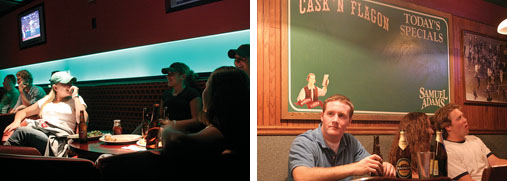
The Cask 'n' Flagon, in contrast, is a wood-paneled, traditional sports bar that one would imagine looks much the same as it did when it opened in 1969, as Oliver's. The walls, adorned with photos of Hub hardball heroes like Carl Yastrzemski, Ted Williams and Carlton Fisk, give the Cask a sense of history amidst the still somewhat incredulous joy of Sox fans following that long-awaited World Series win.
For longtime fans, the Cask's history as a Sox hotspot has made it a local landmark and a rite of passage of sorts. James White, 21, of Randolph, said that "I would walk by when I was a kid going to a game and always wanted to go in."
That reputation leads Bostonians to bring friends and relatives from far and wide to soak in the experience. Victoria Raineri, 27, plans to eventually take her friend Jessica Manhood, 26, recently transplanted from Wisconsin, to Game On, but said, "I wanted her [to come here] first. If you want to see the Sox scene, you want to come to the Cask."
Even a visitor from "enemy" territory-Paul LeGoss from Brooklyn, N.Y.-seemed comfortable at the Cask during a July Yankees-Red Sox game. While hardcore Sox fans are known to be extremely vocal, LeGoss noted that "Everyone's been chill so far." Still, LeGoss couldn't help but comment, "They really do take the game too seriously."
Game On has the edge as far as peeping the celebrities that flood the ballpark when the Yankees come to town. One night during that same July series, famous faces enjoying a pre-ballgame nosh included ex-Sox slugger Sam Horn, PBS cooking show star Ming Tsai and Fever Pitch and Kingpin filmmaking siblings Bobby and Peter Farrelly.
It remains to be seen, however, if hardcore Sox fans will embrace Game On the way generations have the Cask 'n' Flagon. Andrew Lalime, 33, of Watertown seemed let down by the newer bar's lack of a strong Red Sox identity. "It seems sort of like an ESPNZone," he said, referencing the chain of non-partisan sports-themed restaurants which the cable network operates in cities throughout the country.
Another patron was more blunt. "I really wouldn't
consider it a sports bar," said Peter Reuell, 30, of Newton,
comparing the atmosphere at Game On to more of a "meat market,"
before adding, "It needs to be a little grittier. When I go to a
sports bar, I expect sawdust on the floor and a bartender with
one eye."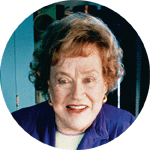
 Cod forbid: Boston's food scene
grows up
Cod forbid: Boston's food scene
grows up
Blame it on our English ancestors-for centuries, Boston cuisine
operated under the motto the blander, the better, with nothing on
local menus but codfish, brown bread and baked beans.eventually a
city reaches its breaking point. Today, Boston is known for a
vibrant and diverse dining scene, and for having turned out some
of the nation's most recognizable celebrity chefs. It started in
the 1960s with our adopted doyenne of the delectable, Julia
Child, and nowadays, internationally known chefs such as Todd
English, Ming Tsai, Jackie Robert, Gordon Hamersley,
Jasper White
and others still call Boston their home base.
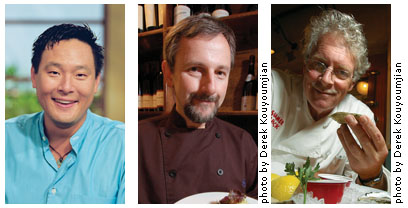

 Ben Franklin, meet Ben Affleck
Ben Franklin, meet Ben Affleck
Boston's proud of its prominent place in our nation's history,
and for close to 50 years visitors have had the opportunity to
walk a red painted line and educate themselves by visiting some
of our most important historic sites on The Freedom Trail.
However, in this day and age, the thirst for knowledge extends to
subjects that move beyond the Revolutionary War and the Bill of
Rights. These days, people also want to know where "Ally McBeal"
and Good Will Hunting were filmed. Enter the Boston Movie Tour,
established earlier this year, which takes participants on a tour
of movie and TV locations within the city of Boston. History or
Hollywood, past or future, Boston has inquiring minds covered.
 The "Banned" Played On
The "Banned" Played On
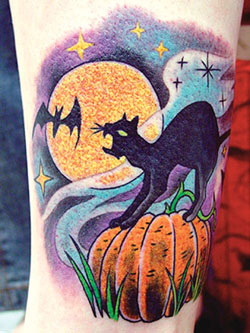
The concept of "Banned in Boston" really began with
the first Bostonians, the Puritans, who-in addition to cracking
down on all the usual vices-actually made celebrating Christmas
illegal from 1659-1681, because it reminded them of the hated
Church of England.
The "Banned in Boston" movement picked up steam in the late 19th and early 20th century when the Watch and Ward Society and social reformer Anthony Comstock found Bostonians unusually receptive to their mission of stamping out "smutty" books, films and plays-shutting down and running out of town many a stage performer and theater owner in the process.
Today, though, Boston's finally achieved moderation in its quest for morality, and we're thought of as a socially progressive city yet again. Getting a tattoo, for example, was taboo from 1962 until 2000, when Massachusetts finally repealed the ordinance against inking, granting Fat Ram's Pumpkin Tattoo in Jamaica Plain the first of many tattooing licenses. In 2003, liquor stores that were once only allowed to be open on Sundays around holidays were permitted Sunday operation year-round. And one can only imagine what members of the Watch and Ward Society would have had to say about last year's historic legalization of same-sex marriage. Luckily for those who enjoy freedom of choice, precious little is "Banned in Boston" anymore.

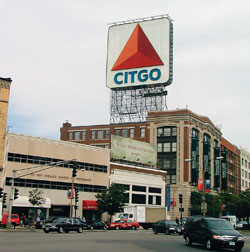 There goes the neighborhood
There goes the neighborhood
No, we don't consider it big news that the neighborhoods in
Boston look different than they did 375 years ago. However, some
of Boston's boroughs have undergone significant changes from even
a couple decades ago. In Kenmore Square in the 1970s and 1980s, a
big night out meant ducking into Cornwall's for a brew, then pogoing next door to "The Rat" for some quality punk rock. Now,
the Kenmore area is in the midst of a renovation focused around
the new Hotel Commonwealth, its cute boutique shops, and trendy,
upscale restaurants like Great Bay and Eastern Standard.
Meanwhile, most locals over the age of 30 can remember coming to
Downtown Crossing with their mom to visit Jordan Marsh and
Filene's. Today, both Jordan Marsh and Filene's have been
swallowed by Macy's, perhaps paving the way for a modern chain
(Target? Wal-Mart?) to take up residence in the spot where many a
first doll, interview suit or prom dress was purchased.

back to homepage